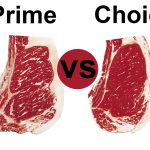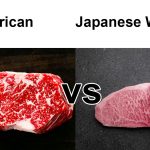When you think of savory steaks, two classic cuts may come to mind: beef tenderloin and filet mignon. They share some similarities but also feature several significant differences in flavor, cost, texture, and appearance.
If you’re trying to decide which one is right for your next dinner party or special occasion meal, this guide will walk you through the pros and cons of each cut so that you can make an informed decision based on your specific needs. With a little background information on the major differences between beef tenderloin vs filet mignon under your belt, rest assured that whichever cut of steak you choose will be delicious!
What is Beef Tenderloin?

Beef tenderloin is a cut of beef taken from the back of the cow. It’s one of the most tender cuts of steak, making it an ideal choice when you want to impress your guests with a melt-in-your-mouth dinner. Its flavor is mild and delicate compared to other cuts, but it can still be enhanced with sauces or rubs if desired.
Beef tenderloin typically comes in two sizes: whole and center-cut. The center-cut option is generally more expensive because it contains less fat and gristle than its larger counterpart, so it has a finer texture and more consistent flavor throughout. In addition, this cut tends to cook more quickly since there’s less fat to render.
Beef Tenderloin Nutrition Facts:
Calories: 210
Fat: 10.6g
Saturated Fat: 3.8g
Cholesterol: 82mg
Sodium: 76mg
Carbohydrates: 0g
Fiber: 0g
Protein: 29.3g
Vitamins and Minerals in Beef Tenderloin:
Vitamin B12 (Cobalamin): 11.2mcg
Iron : 2.1mg
Selenium : 33.5mcg
Zinc : 4.3mg
The beef tenderloin is also a good source of several other essential vitamins and minerals, including phosphorus, magnesium, potassium, copper, manganese, and thiamin. It also contains small amounts of folate and vitamin A. The beef tenderloin is an excellent source of high-quality protein, which helps the body build muscle mass, repair tissues, and make enzymes and hormones. Protein is especially important for athletes or those who are regularly active.
What is Filet Mignon?

Filet mignon is a cut of beef taken from the small end of the tenderloin, near the ribs. Unlike other cuts such as rib-eye or sirloin that are marbled with fat for flavor, filet mignon has very little marbling and therefore a milder taste than some other steaks. This makes it an excellent choice for steak lovers who prefer their beef on the leaner side.
The texture of filet mignon is delicate and smooth, making it one of the most sought-after steaks at restaurants and dinner parties alike. While this cut can be cooked quickly using high heat methods such as grilling or pan-searing, it benefits from a longer cooking time at lower temperatures to ensure that the outside doesn’t become tough and dry.
Filet Mignon Nutrition Facts:
Calories: 178
Fat: 9.3g
Saturated Fat: 3.6g
Cholesterol: 79mg
Sodium: 77mg
Carbohydrates: 0g
Fiber: 0g
Protein: 22.7g
Vitamins and Minerals in Filet Mignon:
Vitamin B12 (Cobalamin): 13mcg
Iron : 1.9mg
Selenium : 30.1mcg
Zinc : 4mg
Filet mignon is also an excellent source of several essential vitamins and minerals, including phosphorus, magnesium, potassium, copper, manganese, and thiamin. It also contains small amounts of folate and vitamin A. Filet mignon is an excellent source of high-quality protein, which helps the body build muscle mass, repair tissues, and make enzymes and hormones. Protein is especially important for athletes or those who are regularly active.
What’s The Difference Between Beef Tenderloin and Filet Mignon
When it comes to beef tenderloin vs filet mignon, there are several key beef tenderloin and filet mignon. For one, beef tenderloin is typically more affordable than filet mignon since the latter is made up of smaller portions of meat taken from the end of the tenderloin.
Due to its lack of marbling, filet mignon also has a milder flavor than other steaks while beef tenderloin has a richer and more robust flavor. Lastly, filet mignon is more delicate and requires careful preparation to ensure that it’s cooked properly, while beef tenderloin is a bit heartier and can withstand longer cooking times and higher temperatures.

6 Difference Between Beef Tenderloin and Filet Mignon
1. Price – Beef tenderloin is usually more affordable than filet mignon
2. Taste – Filet mignon has a milder flavor, while beef tenderloin has a richer flavor
3. Cut Size – Filet mignon is cut from the small end of the tenderloin near the ribs, whereas beef tenderloin can be cut from any portion of the full-length tenderloin
4. Texture – Filet mignon is delicate and smooth, while beef tenderloin is heartier in texture
5. Cooking Times – Since filet mignon has less fat, it requires much shorter cooking times than beef tenderloin
6. Nutrient Profile – Beef tenderloin is an excellent source of essential vitamins and minerals, while filet mignon contains small amounts of folate and vitamin A. Both are excellent sources of high-quality protein.
Beef Tenderloin vs Filet Mignon: What’re The Similarities?
Despite their differences, beef tenderloin and filet mignon are both cuts of beef that are taken from the same part of the cow: the tenderloin. They are both lean and flavorful cuts, but filet mignon is generally considered to be more luxurious since it contains less fat and has a milder flavor profile.
Both cuts are also excellent sources of high-quality protein, making them ideal for athletes or those who are regularly active. Nutrition-wise, they both contain essential vitamins and minerals, which helps promote optimal health and wellness. Ultimately, choosing between beef tenderloin and filet mignon really comes down to personal preference.
Beef Tenderloin vs Filet Mignon: Which Is Better?
Ultimately, the decision between beef tenderloin and filet mignon is a matter of personal preference. If you’re looking for something that’s more affordable and has a more robust flavor, then beef tenderloin might be the better choice. On the other hand, if you’re looking for something luxurious and milder in flavor, then filet mignon would be the way to go. Ultimately, both cuts are excellent sources of high-quality protein so it really comes down to your own tastes and budget!
Beef Tenderloin vs Filet Mignon: What About Flavor?
When it comes to flavor, beef tenderloin is typically richer and more robust in taste than filet mignon. Filet mignon has a milder flavor due to its lack of marbling, while beef tenderloin can take on different flavors depending on the type of seasoning or marinating used. Ultimately, either cut can be cooked in any number of ways making them both great options for creating delicious meals!
How To Cook A Beef Tenderloin?
Beef tenderloin is a cut of meat that can be cooked in many different ways. It can be grilled, seared, roasted, or braised. The key to cooking a perfect beef tenderloin is to get the temperature just right so it’s juicy and flavorful.
Here are some tips for getting the best results when cooking a beef tenderloin:
1. Preheat oven to 375°F (190°C).
2. Rub your beef tenderloin with oil and seasonings of your choice such as salt, pepper, herbs, garlic powder etc.
3. Place the seasoned beef on a foil-lined baking sheet and roast in preheated oven for 25-30 minutes.
4. Insert a meat thermometer into the center of the roast and monitor the temperature until it reaches an internal temperature of 145°F (63°C) for medium-rare or 165°F (74°C) for well-done.
5. Remove from oven, tent with foil, and let rest for 10-15 minutes before slicing and serving.
Cooking a beef tenderloin is a great way to enjoy high-quality protein in a flavorful and juicy cut of meat! With just a few simple tips you can create an amazing recipe that your family will love.
How To Cook Filet Mignon?
Cooking filet mignon is a great way to enjoy this luxurious cut of beef. Unlike beef tenderloin, filet mignon requires shorter cooking times due to its lack of fat.
Here are some tips for getting the best results when cooking filet mignon:
1. Preheat oven to 400°F (200°C).
2. Rub your filet mignon with oil and seasonings of your choice such as salt, pepper, herbs, garlic powder etc.
3. Place the seasoned steak on a foil-lined baking sheet and roast in preheated oven for 20-25 minutes.
4. Insert a meat thermometer into the center of the steak and monitor the temperature until it reaches an internal temperature of 145°F (63°C) for medium-rare or 165°F (74°C) for well-done.
5. Remove from oven, tent with foil, and let rest for 10 minutes before slicing and serving.
Cooking a filet mignon is a great way to impress your guests with a flavorful and luxurious cut of beef! With just a few simple tips you can create an amazing meal that everyone will love.
Common Mistakes To Avoid When Cooking Beef Tenderloin vs Filet Mignon
When cooking either beef tenderloin or filet mignon, there are some common mistakes to avoid.
First, overcooking the meat can lead to a dry and tough result. It’s important to pay attention to internal temperature when cooking either cut of beef and not guess by time alone.
Second, be sure that you season your meat properly with salt and pepper before cooking. This will help bring out the flavor of the beef and ensure it is as juicy and flavorful as possible.
Finally, don’t forget to let your steak rest after cooking for at least 10 minutes before serving. This will allow the juices in the steak to redistribute evenly throughout the cut of meat, resulting in a more flavorful and juicy steak.
FAQs: Beef Tenderloin vs Filet Mignon
What is the difference between beef tenderloin and filet mignon?
The main difference between beef tenderloin and filet mignon is that beef tenderloin has more marbling, which gives it a richer flavor. Filet mignon also tends to be more expensive due to its leaner cut.
How do I know when my steak is done cooking?
The best way to tell if your steak is done cooking is by using a meat thermometer. Insert the thermometer into the center of the steak and check for an internal temperature of 145°F (63°C) for medium-rare or 165°F (74°C) for well-done.
How can I make my steak more flavorful?
The best way to make your steak more flavorful is by seasoning it with salt and pepper before cooking. You can also rub the steak with oil to help lock in flavor and moisture as it cooks. Additionally, adding herbs or garlic powder to the seasoning will add an extra layer of flavor to your steak.
Is beef tenderloin a cheap cut?
No, beef tenderloin is not a cheap cut of meat and typically costs more than other cuts such as flank steak or sirloin. However, it is still less expensive than filet mignon which tends to be the most expensive cut of beef.
Is tenderloin the best cut of steak?
It depends on your preference! Tenderloin is a great choice for those who want a juicy and flavorful steak, but filet mignon is often considered the most luxurious cut of beef. Ultimately, it’s up to you to decide which cut will suit your needs and tastes best. Beef tenderloin and filet mignon are both delicious cuts of beef that can be used to make amazing meals. With just a few simple tips you can create an amazing recipe that your family will love. Whether you opt for the more marbled beef tenderloin or the luxurious filet mignon, make sure to follow these tips to get the best results when cooking either cut of meat.
Is filet mignon the most tender cut of beef?
Yes, filet mignon is considered to be the most tender cut of beef. Its leaner texture and lower fat content make it incredibly tender and juicy. It can also be cooked quickly due to its small size, making it a great option for a fast weeknight dinner.
Conclusion:
When deciding between beef tenderloin and filet mignon, it really comes down to personal preference. While both cuts are excellent sources of high-quality protein, they each have their own unique flavor profiles and cooking methods. Beef tenderloin is typically richer and more robust in taste, while filet mignon has a milder flavor due to its lack of marbling. Ultimately, either cut can be cooked in any number of ways making them both great options for creating delicious meals! So whether it’s beef tenderloin or filet mignon, you’re sure to find something that will satisfy your taste buds.
Thanks for reading! We hope this article has helped you understand the differences between beef tenderloin and filet mignon so you can make an informed decision when choosing which one is right for you!
References:
https://en.wikipedia.org/wiki/Beef_tenderloin
https://en.wikipedia.org/wiki/Filet_mignon

William Lariviere is a chef and restaurateur with over 25 years of experience in the food industry. He is the owner and operator of Swartzsdeli.com, an online restaurant that specializes in gourmet sandwiches and salads, grill & smoke. He likes to share experience, food, recipes cooking knowledge as well as reviews about restaurant and kitchen products.
William’s goal is to provide his customers with healthy, delicious food that is also affordable and develop Swartzsdeli.com into a comprehensive information site specializing in cooking and cuisine to a new level to help reach a wide range of housewives and readers.








